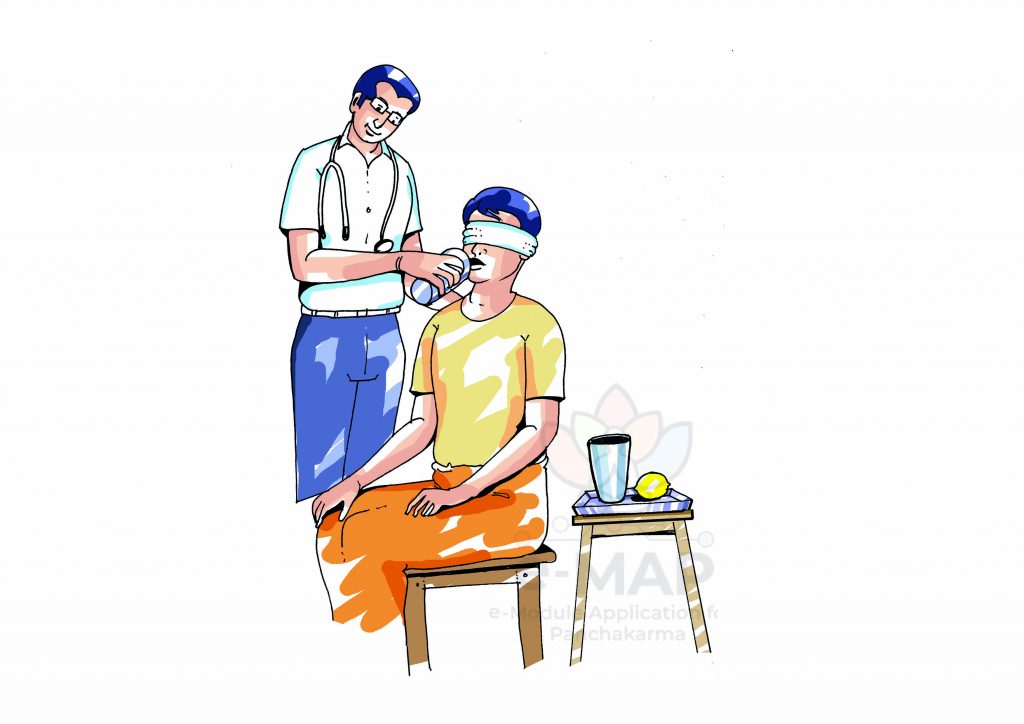
Basic Module 2 - Lesson 1
SNEHANA

EXPLANATORY NOTES
- Etymology of Sneha and Snehana
1)णिच्-ल्युट्-वाचस्पत्यंस्निह-
2) स्निह+घञ् (धातु).
तैलादिमर्दने अभ्यङ्गे।
3) It belongs to theनपुंसकलिङ्ग When ल्युट्pratyaya is added withस्निह्dhātu– Thewordस्नेहनis formed.
It is derived byघञ्प्रत्यय in snigdha which means affection.
- Definition of Sneha and Snehana
स्नेह-स च गुणःजलस्यचूर्णादिपिण्डीभावहेतुः ।Sabdakalpadruma
The quality which is derived from jala-mahabhuta and responsible for mixing powders etc.
स्नेहनंस्निग्धकारिणी।– शब्दकल्पद्रुमं
स्नेहै:-उत्क्लिष्टं
उत्क्लेष-उत्क्लिष्टानितिहृल्लासदीनांबहिर्गमनोन्मुखान् –हेमाद्रि
तैलादिद्वारामर्दनंवाअभ्यङ्ग -vācaspatya
The process, in which snigdhatā of the body is brought about is called as Snehana.The substance, which brings oiliness or unctuousness to the body and mind is snehana.
Rājanighaṇṭu explains tailādimardana as Snehana. A similar explanation is found in Śabda stoma mahānidhi.
दर्शनस्पर्शनेवापिश्रवणेभाषणेऽपिवा।
यत्रद्रवत्यन्तरङ्गं स स्नेह इतिकथ्यते। – शब्दकल्पद्रुमं
If the person feels unctuousness immediately (mentally & physically) by touching,hearing even by mere sight of the substance it is called Snehana.
स्नेहनंस्नेहविष्यन्दमार्दवक्लेदकारकं। – च.सू.२२/११
विष्यन्दोविलयनं।– चक्रपाणि
Snehana is the process by which sneha(unctuous) Viṣyandana (diffusion), mṛdutā (softness), kledana (moistness) of the body are brought about.
Snehana causes diffusion, overflowing and excretion of vitiated doṣas. The moisture and softness signify the increase of āpyaguṇa (jala) of body.
स्थावरस्नेहः
The fat obtained from plants is called स्थावरस्नेहः The examples include sesame oil, Castor
oil, mustard oil, Karañja oil, etc
जाङ्गमस्नेहः
The fat obtained from the animal origin is called जाङ्गमस्नेह. Milk, Curd, Butter, Ghee,
Marrow fat and Muscle fat are examples.
गुरु-शीत-सर-स्निग्ध-मन्द-सूक्ष्म-मृदु-द्रवम्।
औषधं स्नेहनं प्रायो विपरीत विरूक्षणम्॥ – अ.हृ.सू-१६/१-२
If the substances possess Heaviness, Cold, Spreading, Dull, Soft and Fluidity, then it is said
to be an unctuous substance.
द्रवं सूक्ष्मं सरं स्निग्धं पिच्छिलं गुरु शीतलम्।
प्रायो मन्दं मृदु च यद् द्रव्यं तत्स्नेहनं मतम्॥ – च.सू.२२/१५
The properties of sneha dravyas are Liquid, Subtle, Fluid, Unctuous, Slimy, Heavy, Cold,
Sluggish and Soft.
Charaka added picchila guṇa to it.
गुरु शीत सर स्निग्ध मन्द सूक्ष्म मृदु द्रवं।
Arunadutta explains that though the above said qualities are must for sneha dravyas, there are
exceptions.
Sarṣapa tailaṃ, though it is uṣṇa, it acts as snehana. Other examples are chāgadugdham,
matsya and māhiṣa māṃsa. To emphasise this, the word ‘prāyo’ is used.
Sneha guṇa is also found in 24 guṇas of Nyāya vaiśeṣika. To conclude, sneha is the term used
for Sneha dravyas and the procedure by which snigdha, mārdava, viṣyanda and kleda is
brought about in the body.
IMPORTANT SLOKA
स्नेहनं स्निग्धकारिणी। (शब्दकल्पद्रुमं)
The process, in which snigdhata of the body is brought about is called as Snehana.
स्नेहनं स्नेह विष्यन्द मार्दवक्लेदकारकं। (Ch.Su.22/11)
Snehana is the process by which Sneha (unctuous) Viṣyandana (diffusion), mṛdutā (softness), kledana (moistness) of the body are brought about.
गुरु-शीत-सर-स्निग्ध-मन्द-सूक्ष्म-मृदु-द्रवम्।
औषधं स्नेहनं प्रायो विपरीतं विरूक्षणम्॥ (AH.Su.16/1-2)
If the substances possessing qualities like heaviness, cold, spreading, dull, soft and fluidity, is said to be an unctuous substance.
द्रवं सूक्ष्मं सरं स्निग्धं पिच्छिलं गुरु शीतलम्।
प्रायो मन्दं मृदु च यद् द्रव्यं तत्स्नेहनं मतम्॥ (Ch.Su. 22/15)
Sneha dravyas are said to be liquid, subtle, fluid, unctuous, slimy, heavy, cold, sluggish and soft in nature.



